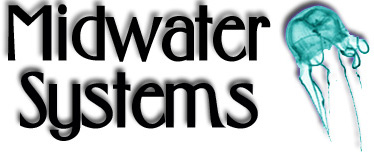|
Introduction to Centropyge, Dwarf or Pygmy Angelfish
Of all the fishes in the ocean the family of Angelfishes is, in my opinion, the
most attractive. Within this family is a group called centropyge, or more commonly
called the dwarf or pygmy angels. The poster fish
for this family most likely being the vibrant red flame angelfish.
My first impression of the dwarf angelfish family was that of
stunted or growth inhibited fishes, but not at all. These little fish possess all the
energy and attitude as their larger cousins, they are just simply compacted into a scaled down
version.
If I recall my fist dwarf angel, back in 1984, was a Keyhole,
followed by the Cherub, and then....well, let's just say I got carried away as i
do like
angelfish. Since that time I have had the opportunity to see and keep most of
what the aquarium hobby can bring in. This does not make me an expert, but it
does provide me with experience.
When shopping for a pygmy angel make it a point to note two
things; richness of overall color, and is the fish aware of his surroundings. Select
fish with deep rich color. Fish that are pale should be an indication that
something is bothering the fish. Fish should react in a defensive, yet curious
manner, when you approach the aquarium. They should be aware of your presence,
raise their dorsal fin and exhibit a defensive posture. It is expected that they
will seek a hiding spot but that their curiosity will cause them to peek out at
you.
Pygmy angels like all other fish are subject to marine
parasites such as Ick. Copper based medications are very effective but must be
used in one half dose increments as centropyge species do not tolerate immediate
full dose applications.
As with other fish families it is difficult to add additional
similar species when one species is already established in the aquarium, but not
impossible. Many of the tanks I have owned or maintained include more than one
within the same genera. Established fishes will sometimes relentlessly defend
their tank choosing to viciously beat up the new addition.
In regards to creating male and female pairs I have found
this to be quite easy. All centropyges are born female. The larger or more
dominant individuals will actually change sex and become males. Knowing that
size is the main difference between the sexes, and not so much coloration, all
one needs to do is place a small and larger version together. Within
approximately 60 days either one of the two fish will have physically changed
sex to accommodate each other and / or the two will have accepted their sexual
role and have paired up.
Centropyge are broadcast spawners and spawning occurs at
dusk, or at the end of the light cycle in the aquarium. I have found that by
using a series of timers controlling more than one or two separate sets of
lights I could create a sunset effect. The timers allowed for a consistent time
frame that mimicked the rise and fall of the sun. Just as the last set of lights
shown in the tank the male would begin his nightly courtship. In nature this
courtship occurred with more than one female as centropyge live in harems of six
to ten individuals.
The recent successes in tank spawning and raising of
centropyge specimens will ensure their continued availability, including rare
specimens and eventually bring costs down.
Dwarf angels tend to accept all forms of foods. I have found
that in the beginning it was good to get them feeding on frozen Mysis. This food
seems to get their attention as a result of the high amount of oils and lipids
it contains. Over time a variety is best for any fishes. Pygmy's will nip at
algaes and small invertebrates, especially tanks furnished with live rock. Many
hobbyists have reported that one species tends to enjoy nipping at live corals
more than others. I have experienced some problems with some fish but nothing to
suggest a particular species over another.
Here is some more definitive information,.... |
Classification
Reproduction In The Wild
Reproduction
In Captivity
Aquarium Environment
Centropyge acanthops, African Pygmy Angel
Centropyge argi, Cherub, Yellow Face Pygmy Angel
Centropyge aurantia, Golden Angelfish
Centropyge aurantonotus, Flameback Angel
Centropyge bicolor, Bicolor
Angel
Centropyge bispinosa, Coral Beauty Angel
Centropyge colini, Colin's Pygmy
Angel Centropyge debelius, Blue Mauritius Angelfish
Centropyge eibli, Eibli or Candy Stripe Angel
Centropyge ferrugata, Rusty Angel
Centropyge fisheri, Fishers Pygmy Angel
Centropyge flavicauda, White Tail Pygmy Angel
Centropyge flavissima, Lemonpeel Angel
Centropyge flavipectoralis, Yellowfin Pgymy Angel
Centropyge hotumatua, Hotumatua's Angelfish
Centropyge interuptus, Japanese Pygmy Angelfish
Centropyge joculator, Coco's Pygmy Angelfish
Centropyge loriculus, Flame Angel
Centropyge Multicolor,
Multicolor Pygmy Angelfish
Centropyge mutispinis, Multi-Spined Angelfish
Centropyge nahackyi, Nahacky's Pygmy Angelfish
Centropyge narcosis, Deep-Reef Pygmy Angel
Centropyge nigriocella, Black-Spot Pygmy Angel
Centropyge nox, Midnight or Black Pygmy Angelfish
Centropyge potteri, Potters Pygmy Angelfish
Centropyge resplendens, Resplendent Pygmy Angelfish
Centropyge shepardi, Shepards Angel
Centropyge tibicen, Keyhole Angel
Centropyge vroliki, Half Black Pygmy Angel
Centropyge woodheadi, Woodheads Angelfish
Paracentropyge Boyeli, Peppermint Angel
Paracentropyge Multifasciata, Many-Banded Angel
Paracentropyge / Sumireyakko venustus, Venustus Angel
Contact and Copyright
|






 Manufacture of custom acrylic jellyfish
tanks, plankton kreisel
and holding systems used to keep midwater collections and gelatinous
organisms in suspension.
Manufacture of custom acrylic jellyfish
tanks, plankton kreisel
and holding systems used to keep midwater collections and gelatinous
organisms in suspension.


 Aquariums,
Ponds, Fish and Aquatic Information.
Aquariums,
Ponds, Fish and Aquatic Information.